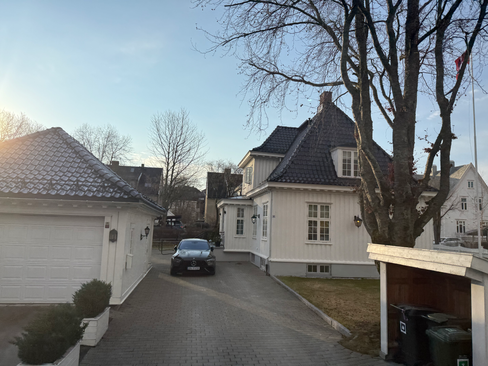Trondheim & Nidaros Cathedral
Our day began with an early excursion, exploring the beautiful city of Trondheim. We wandered through its charming old town and marvelled at the awe-inspiring Nidaros Cathedral.
After disembarking at the port, we boarded a bus that took us through winding streets, past historic buildings, and up to a scenic viewpoint overlooking the city. Our guide, a university student originally from Pakistan, shared fascinating insights into Trondheim’s history and modern life. From our vantage point, we could see everything—the fjord, the fortress-turned-museum on an island reminiscent of Alcatraz, and the towering cathedral spire. The crisp morning air made the view even more breathtaking.
We drove past the sprawling Norwegian University of Science and Technology and the nearby houses traditionally for the professors.
Soon arriving in the city centre, we had the chance to walk over the famous city bridge. Legend has it that crossing this bridge brings good luck. I’d say the superstition held true—Jase and Drew, who had stopped for coffee, caught up with us just in time to hand us hot drinks as we crossed!
The green corner building was the cafe where Jase and Drew sourced our coffee, and they caught up with us on the bridge.
A short walk later, we stood before the grand Nidaros Cathedral. Massive, gothic, intricate—words hardly do it justice.

Inside, two guides narrated the stories of Saint Olaf and the cathedral’s complex history. One of the most remarkable stories was about the cathedral’s three organs, particularly the Wagner organ, discovered in the basement by a Nazi soldier who wanted to claim it but was denied. Now restored, it remains one of only three Wagner organs in existence.
After finishing our city tour, we returned to the port, where we saw a Hurtigruten line ship docked next to our Havila ship. Comparing the two, we felt confident in our choice—the Havila was noticeably larger and more modern.
Then, the weather turned.
Rain lashed sideways, and the sea grew rough as we set sail. But the adventure wasn’t over. That afternoon, we took another excursion—to the Atlantic Road and the Bergtatt Marble Mine.
Kristiansund: A City on Four Islands
Our journey began in Kristiansund, a city of 24,000 residents known for its dried and salted fish (clipfish). We drove through a remarkable 5.6km tunnel, plunging 250m below sea level, before stopping at a historic stone circle where King Harald Fairhair vowed not to cut his hair until he had united Norway.

The Atlantic Road: A Stormy but Spectacular Drive
The Atlantic Road, an 8km stretch connecting a series of islands via eight stunning bridges, is a feat of engineering. The scenery was incredible, but the weather? Brutal. The wind howled, and rain pelted us sideways, making for some hilarious, puffed-up-jacket photos that made us look like Michelin men! No wonder this stretch of coast has seen dangerous shipwrecks, including the Viking Sky cruise ship’s near disaster in 2019.

Bergtatt Marble Mine
From the stormy coast, we journeyed into the depths of the Bergtatt Marble Mine. The bus drove deep into the mountain, where we donned hard hats and life jackets before boarding small boats that floated on eerily clear spring water. Coloured lights and hidden speakers transformed our ride into something magical. We even tasted fresh spring water tapped from the rocks—deliciously pure!
After our boat ride, we gathered in an underground concert hall for a warm meal of soup and more spring water while watching a film about the mine’s history. Then came the nerve-wracking descent out of the mine—a winding dirt track in the dark and pouring rain. We of course traversed it to get in, but it seemed simpler in the daylight! Quite lucky we couldn't see a thing as passengers.
A Delayed Boat and an Unwelcome Surprise
Instead of returning to Kristiansund, we travelled to Molde, where our ship had moved ahead without us (as planned). However, due to rough seas, the ship was delayed. So, we stood in the rain for ten minutes, watching it finally dock.
One unfortunate fellow traveller had fallen ill in the mine, blaming motion sickness from the still-as-glass boats. The crew, however, wasn’t convinced—it seemed more like a stomach bug. Hand sanitiser was generously distributed as we embarked, and we carefully avoided touching anything she might have handled!


























































Comments